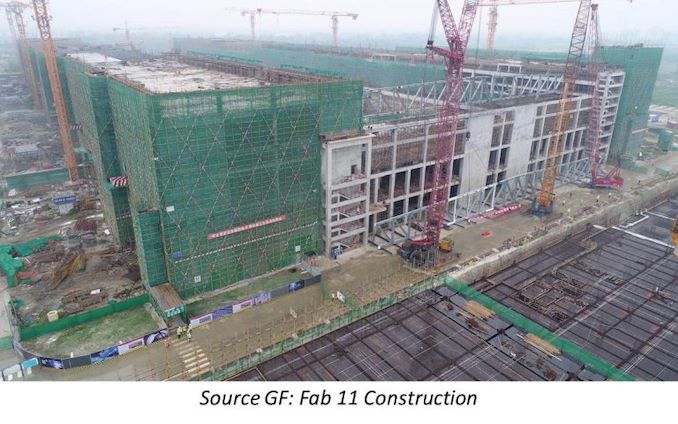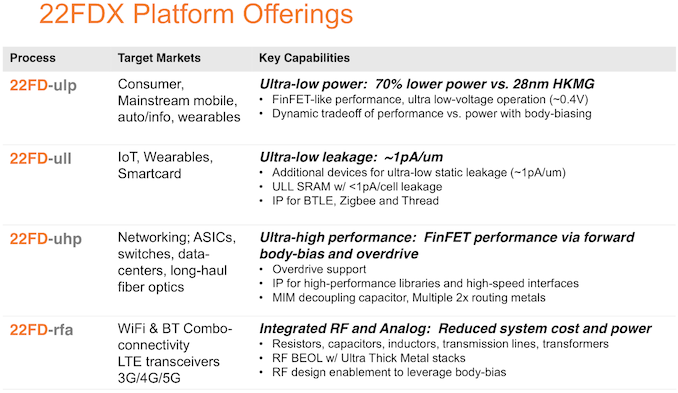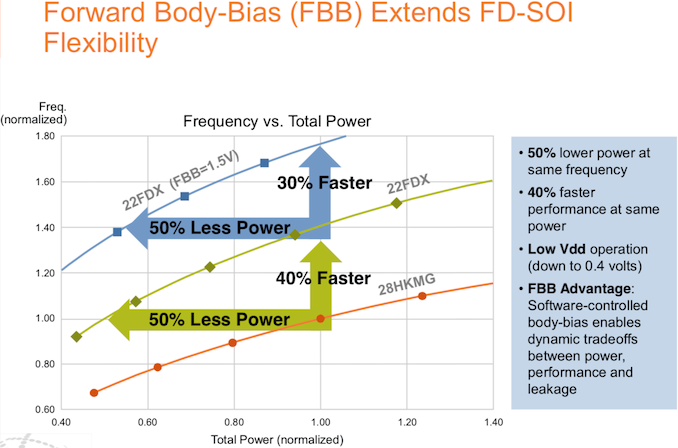GlobalFoundries and Chinese Authorities Reconsider Plans
by Anton Shilov on November 26, 2018 1:00 PM EST- Posted in
- Semiconductors
- GlobalFoundries
- FD-SOI
- 12FDX
- 22FDX
Because of its renewed focus on specialized process technologies and competition, GlobalFoundries has opted to reconsider its plans concerning its Fab 11 located near Chengdu, China. Rather than offer mature bulk fabrication technologies, the manufacturing facility will focus on FD-SOI and other differentiated processes. In addition, GlobalFoundries and its partners from China are now revising their timeline for the fab, removing parts of the project to accelerate straight into its second phase of deployment.
Fab 11 was/is built as a partnership between GlobalFoundries and the Chengdu municipality. The original plan for the Chengdu fab included two phases with an aggregated capacity of approximately 1,000,000 wafers per year when both operate at full capacity. The first phase was to start operations in 2018 and process around 20,000 wafers per month using mainstream 180/130 nm fabrication technologies originally developed by Chartered for various general-purpose chips. The second phase was to begin operations in 2019, use GlobalFoundries’ 22FDX process and gradually expand its capacity to 65,000 wafers per month. At the same time, one of the terms of the agreement between GF and the Chengdu municipality was to develop an FD-SOI ecosystem locally.
Based on various reports, GlobalFoundries has failed to land orders for chips to be made using bulk 180/130 nm fabrication processes. As a result, the company will not equip its Fab 11 for those processes, but instead will jump straight to 22FDX. So far, GlobalFoundries has landed orders from six customers in China for 22FDX chips and these clients are currently ramping up their wafers at Fab 1 in Dresden, Germany.
“Given GlobalFoundries' renewed focus on differentiated offerings and discussions with potential clients, we have decided to bypass the original phase-one investment in mainstream process technology,” a GlobalFoundries executive said in an interview with DigiTimes. “In order to meet demand from China for differentiated offerings including our 22FDX technology, we have to revise the original timeline in order to better align capacity.”
The company does not comment on the volumes and capacities these six companies need, nor the volumes or capacities it expects to be needed in the future. However, at present, GlobalFoundries and the Chengdu municipality are reconsidering their plans regarding the fab. Meanwhile, the company still expects its Fab 11 to feature a “substantial” FD-SOI capacity.
“The timetable on when the Chengdu fab will kick off commercial production is still being discussed between GlobalFoundries and the Chengdu municipality and will be available when we reach a consensus,” an executive said.
Keeping in mind that right now GlobalFoundries does not have a clear understanding regarding its fab in Chengdu, it is obvious that the facility will struggle to begin operations in early 2019 and it remains to be seen when exactly it is set to start processing wafers in 2020.
Although the Fab 11 project looks to be stalled, other FD-SOI projects are developing as planned. The company is on-track to start production of chips using its 12FDX manufacturing technology in early 2019 at Fab 1, which looks like a rather aggressive plan. The 12FDX promises to provide a 26% performance improvement or a 47% lower power when compared to 22FDX, which brings it close to 10-nm-class fabrication process from competitors.
Related Reading
- GlobalFoundries Announces 22FDX Milestone: $2 Billion in Design Wins
- GlobalFoundries to Expand Capacities, Build a Fab in China
- GlobalFoundries Stops All 7nm Development: Opts To Focus on Specialized Processes
- Change of Strategy: A New GlobalFoundries CEO in Dr. Thomas Caulfield
Source: DigiTimes













21 Comments
View All Comments
Yojimbo - Tuesday, November 27, 2018 - link
Just because it concerns politics doesn't mean it's not true or not directly related to technology.Loenrankez - Tuesday, November 27, 2018 - link
Do you know the difference between fact and conjecture?levizx - Friday, November 30, 2018 - link
Your comment is just silly. It's not "just because it concerns politics", it's not true because, well, big surprise, IT IS NOT TRUE.Both x86-compatible produced by Chinese companies are in partner with x86 license holders.
So no, it's not true because it simply defies FACTS, and no it's not related to technology because a simple Google search can reveal the false accusation yet he/she post the false accusation anyway - that means it has nothing to do with technology and everything to to do with dirty politics and racism.
https://arstechnica.com/information-technology/201...
https://www.pcgamesn.com/via-chinese-x86-cpu-match...
iwod - Tuesday, November 27, 2018 - link
AMD already has an agreement with Chinese CCP to Fab special EPYC (I suspect without PSP, technology similar to Intel ME ) with TSMC under a JV.But seriously some of these stuff is getting ridiculous, which part of free trade demands one to form a JV or give in to your IP before you do business with them?
Lord of the Bored - Tuesday, November 27, 2018 - link
They already did. Intel is actually a shell corporation for Shenzong Electronics. Has been for years. Why do you THINK the Pentium 4 happened?levizx - Friday, November 30, 2018 - link
you are an idiot, a racist, and a troll.levizx - Friday, November 30, 2018 - link
A simple Google search tells you Intel AMD and VIA all have partnership with China to produce x86 chips. Sure, it may very well be free, we don't know the terms. But you can't steal with permission, that's a fact.ABR - Tuesday, November 27, 2018 - link
Time will tell but it feels like GF cut off the legs of their future in deciding to abandon the race to smaller scales. Here they are flogging lower power and higher performance, how long is that going to last as TSMC and Samsung continue to lower scales? Sure, there'll always be a market for not-the-latest-and-greatest, but even that will shift over time as the high end improves. If Samsung is happy to sell the yields from their unused 7nm equipment as they go to 5 and 3 to makers of washing machines and el-cheapo electronic devices, where is GF making its money?mpbello - Wednesday, November 28, 2018 - link
Developing a FINFET processor for 7nm can cost close to half a billion dollars. Not all chips have the need or demand that justifies such expensive development. On the other hand, planar manufacturing processes are much cheaper to design for, and GloFo's FDSOI is leading edge planar.Targon - Thursday, November 29, 2018 - link
The real key is looking forward, not just where you are currently. As 7nm matures and things move on to 5nm and other newer technologies, because costs DO go down as the fab process improves, why would any company bother with 14 or 12nm? Remember, other than the development cost and the issue of yields, the smaller nodes actually makes chips cost less to manufacture.Global Foundries was close to having that 7nm fab process, with AMD planning on using Global as one source of 7nm chips and TSMC the other, before Global decided to just give up. It would be like being only a half mile from the finish line of a marathon and then giving up.